ISSN ONLINE(2319-8753)PRINT(2347-6710)
ISSN ONLINE(2319-8753)PRINT(2347-6710)
G Vijaya kumar1, V Krishna2, Sukumar Roy3 and Pushpa Agrawal4
|
| Related article at Pubmed, Scholar Google |
Visit for more related articles at International Journal of Innovative Research in Science, Engineering and Technology
The coagulant protein from Moringa oleifera seeds were purified using nano-structured zirconium (NSZ) particles as a bio-adsorbent by conducting continuous bed adsorption studies based on the Isoelectric Point (pI) of the zirconium and coagulant protein. The characterization of purified protein was done by conducting COD of waste water and results were compared with proteins purified by standard IEX chromatography method and the characterization of NSZ particles was done by Scanning Electron Microscope. The adsorption isotherms of purified protein on NSZ particles at different adsorbent concentration at pH 7.0 were experimentally obtained by batch studies the results follows the Freundlich and Langmiur isotherm adsorption model. The series of column tests were performed to determine the breakthrough curves at different bed depths. The results indicated that the NSZ particles were effective in purifying the proteins based on pI.
Keywords |
| Nano-structured zirconium, Coagulant proteins, SEM, Adsorption. |
INTRODUCTION |
| Moringa oleifera is a multi-purpose tree which is a source of fruit, fodder, herbal medicine, nectar for bees and fuel; in addition, it can be used for hedging and as a support for climbers. It also yields material for the paper industry. It grows faster than eucalyptus trees and bears fruit after less than a year. A horticultural station in Tamil Nadu even succeeded in growing the tree as an "Annual Moringa", with two harvests was reported by Jahn et.al. [1]. In certain environments Moringa oleifera could be replaced as a "coagulant crop” by other Moringaceae family. Jahn [9] reported the most promising Moringa stenopetala which have been shown to contain similarly efficient primary coagulants. |
| It was reported that MO could achieve turbidity removal between 92 and 99%. Coagulation effectiveness of MO varies depending on the initial turbidity. It is very effective for high turbidity waters and shows similar coagulation effects as alum. However, the effectiveness reduces for low turbidity water. The use of MO as a primary coagulant is more appropriate for surface waters with excessive turbidity particularly during the rainy seasons. For low turbidity water it may be effectively used as a coagulant aid. The seed kernels of Moringa oleifera contain significant quantities of low molecular-weight, (water-soluble proteins) which carry a positive charge. Gassenschmidt et al. [2] described the coagulant protein present in Moringa oleifera which is water soluble cationic peptide with Isoelectric Point (pI) above 10 and molecular mass of 6.5 Kda. When the crushed seeds are added to raw water, the proteins produce positive charges acting like magnets and attacking the predominantly negatively charged particles (such as clay, silk, bacteria, and other toxic particles in water). The flocculation process occurs when the proteins bind the negatives charges forming flocs through the aggregation of particles which are present in water. These flocs are easily to remove by settling or filtration. |
RELATED WORK |
| There are different protocols to purify proteins depending upon their size, shape, charge, hydrophobicity and solubility. In general, Kennedy et al. [3] explained the initial step involves in separation involves the extraction of crude protein in saline or buffer solution. From the crude extract, the protein can be separated through different methods, these separation techniques includes ion exchange described by Yan et al. [4], gel filtration chromatography described by Rego et al. [5] and affinity chromatography in all these separation techniques ion Exchange Adsorption (IEX) chromatography is the most common technique in purification. |
| Protein purification in IEX is based on the ion exchange of proteins on the surface of matrix, the most commonly used matrix are diethylaminoethyl (DEAE) as anion exchanger and carboxymethyl (CM) as cation exchanger. In the present purification method, we have used nanostructured zirconium (NSZ) in place of matrix and charged positively depending on the pH of the aqueous solution and pI of the powder explained by Xu Hong Wang et al. [6]. All the oxides can be charged base on their pI and incoming solution pH, if the pH is below the pI of the oxide the oxides surface charge will be positive, and pH above the pI the surface charge will be negative. The pI of silica, titania, zirconia and alumina are respectively close to 2, 5, 7, 9 respectively. Zirconium particle at the neutral pH (around 7) is slightly positively charged in aqueous suspension, at pH below 5.0, the alumina powder is positively charged. This result suggests that the zirconium particles can be used as a bioadsorbent material to purify the coagulant proteins from Moringa Oleifera seeds which contains 35-38% of proteins. The parameters such as, pH, and adsorbent concentration for adsorption was optimized using batch adsorption studies before continuous adsorption. Langmuir and Freundlich isotherms were used to fit the model data at the end to validate the results. |
MATERIAL AND METHODS |
| NSZ particles adsorbent material was synthesized by spray pyrolysis method using a known liquid precursor. Drumstick seeds purchased by near local market were dried in oven and used for the experiment. The derived NSZ particles were also examined by using SEM respectively. |
EXPERIMENTATION |
| Crude protein extraction: The extraction of crude protein was carried out based on the procedure described by Ghebremichael et.al.2006. Moringa oleifera seeds deshelled and dried under sunlight and stored at room temperature. The dried seeds kernel was crushed using a drop weight crusher. 10 gm of powder were mixed with 90 ml of acetone for 30 min and centrifuged at 10000 rpm for 20 min at 5oC and the resulted pellet was dried at room temperature. The dried pellet was suspended in 5% (w/v) ammonium acetate buffer (10 mM, pH 7.0). The solution was mixed for 30 min and filtered using filter paper (Whatmann paper No. 3). The filtrate was termed as crude extract was stored and used for the present work. The amount of protein was estimated by standard Lowry’s protein test. |
RESULTS AND DISCUSSION |
| Effect of Solution pH on Adsorption of Crude MO protein: 1.0 g of NSZ particles were taken separately in 8 centrifuge tubes containing 15ml of crude protein in each of the tubes at pH varying from 2 to 9. The contents in the centrifuge tubes were mixed well for 45 min and centrifuged at 10000 rpm for 20 min the supernatant collected was subjected for Lowry’s method to determine the percentage of adsorption. |
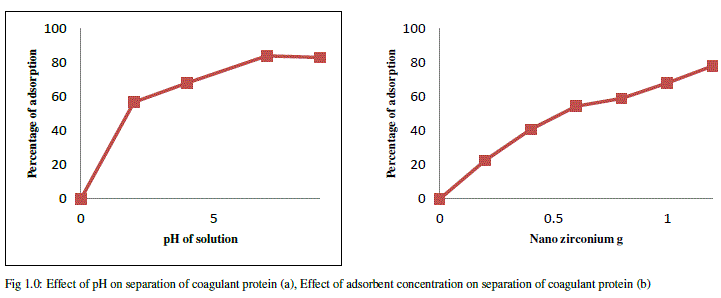 |
| The adsorption of crude MO proteins (Separation of group of coagulant proteins) on NSZ particles were investigated at different pH of the crude MO proteins from 2 to 9. The results of the above graph (Fig 1.0a) indicate the adsorption of MO proteins is 57% at pH 4.0, further the adsorption increased to 84% with increase in pH from 4.0- 9.0 and become constant. This may be due to the more surface area of the NSZ particles; the increase in the solution pH of crude MO proteins, the NSZ (pI 5.0) gets negative charge due to their pI therefore the group of proteins possessing cationic charge adsorbed on to the surface of NSZ. The coagulant proteins basically possessing cationic charge protein of pI 9.6 adsorbed onto the surface of NSZ particles when the pH of the solution increases. The pH 7.0 for further adsorption studies is selected as optimum pH. |
| Effect of Adsorbent Concentration on Adsorption of crude MO Protein: 15ml of crude extract is taken in twelve centrifuge tubes and NSZ is varied from 0.2 to 1.12 g. The contents in the tubes were mixed well for 45mins (Optimum time) at pH 7.0 (Optimum pH) and then centrifuged for 20 min at 10000 rpm. The supernatant collected was estimated by standard Lowry’s method using spectrophotometer at 660 nm. The results (Fig 1.0 b) indicate the increase in adsorption with respect to the concentration of adsorbent. In case of zirconium the adsorption was 23% for 0.2 gm of adsorbent and the adsorption increases as increase in adsorbent from 23%- 78% for further increase in the concentration of adsorbent, the percentage of adsorption of proteins on zirconium was significantly good, this was due to the more specific area and pI (5.0) of zirconium which holds good for adsorption. |
| Desorption of coagulant proteins: 15ml of phosphate buffer at pH 4.0 is added to the 1.0 g of NSZ particles after adsorption of coagulant proteins. The contents in the centrifuge tube were mixed well for 45mins and then centrifuged for 20 min at 10000 rpm. The supernatant collected was estimated by standard Lowry’s method using spectrophotometer at 660 nm. |
| Mathematical Models for Separation of Coagulant Protein s from MO Seeds: The experimental data obtained from the adsorption of coagulant proteins at different adsorbent concentrations is used to fit the Langmuir and Freundlich isotherms models explained by Treybal [8]. |
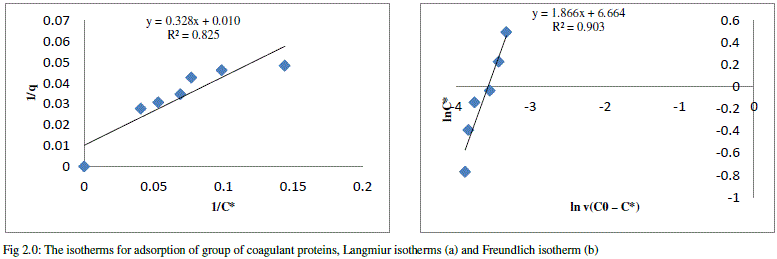 |
| From the nature of the graphs (Fig 4.0 and 5.0) it confirms that the adsorption of coagulant protein on NSZ follows the Langmiur and Freundlich isotherm model with an slope value of 0.328 for Langmiur and 1.866 for Freundlich with an regression constant greater than 0.8. The slope value of zirconium is more than the alumina in both of the mathematical model which indicates that the zirconium is more suitable than alumina for adsorption of coagulant proteins. From the batch adsorption studies the optimum pH (7.0), contact time (45 min) and adsorbent concentration (0.1 gm) were selected to conduct the continuous column studies. |
| Continuous Column Studies: The continuous adsorption is carried out in a packed bed adsorption column of dia 18 mm and length 100 mm at an ambient temperature. The column was filled with dried NSZ for a bed height of 15 mm. A solution of crude MO extracts of initial concentration 2.12 mg/ml at pH 7.0 was continuously fed from top of the column at a flow rate of 60ml /h until break through point was reached. During the column run the effluent samples were intermittently collected by the fraction collector for every 5 minutes and analyzed for concentration of protein in the effluent. Similarly the experiment is repeated for NSZ for 15 mm and 25 mm depth. |
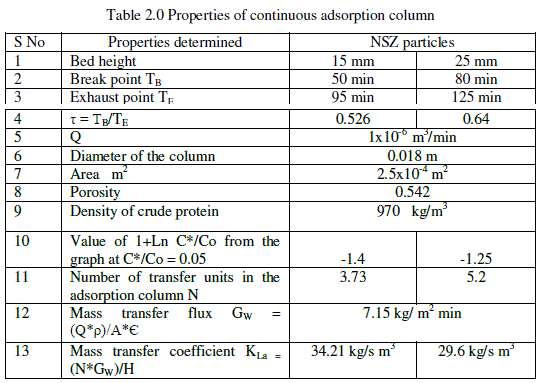 |
| Break through curve: Break through curve of C*/C0 V/s time for the bed height of 15mm and 25mm is drawn (Fig ..) from the results obtained from the continuous adsorption of Moringa oleifera proteins over the zirconium ceramic particles at a flow rate of 60 ml /h. |
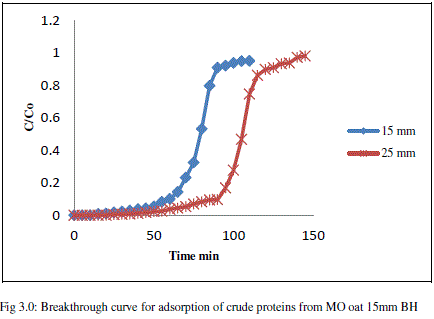 |
| From the above graphs it is observed the break point for adsorption of protein on zirconium the break point is 50 min (15 mm BH), 95 min (25mm BH) and exhaust point is 80 min (15 mm BH) and 125 min (25mm BH), this was due to the alumina is more porous than the zirconium and the coagulant proteins is having more affinity towards zirconium. Increase in bed height increases the contact time between the adsorbent and adsorbate and the break time increases by 44% and exhaust time increase by 40% this shows that the more the bed height the more the adsorption. |
| Determination of Mass transfer Co-efficient: The overall mass transfer coefficient were determined according to the method explained by the N. Vukojeviæ Medvidoviæ et al. [7] for the separation of coagulant proteins on the NSA and NSZ ceramic particles using continuous adsorption by the method discussed in the theoretical analysis. |
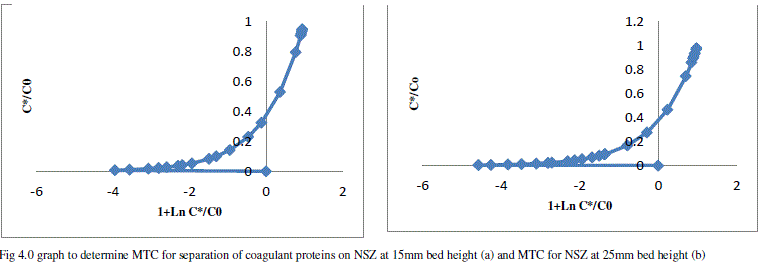 |
| From the above graphs (4.0 a and b) the value of x-axis at the y-axis value of 0.1 is determined to calculate MTC. |
 |
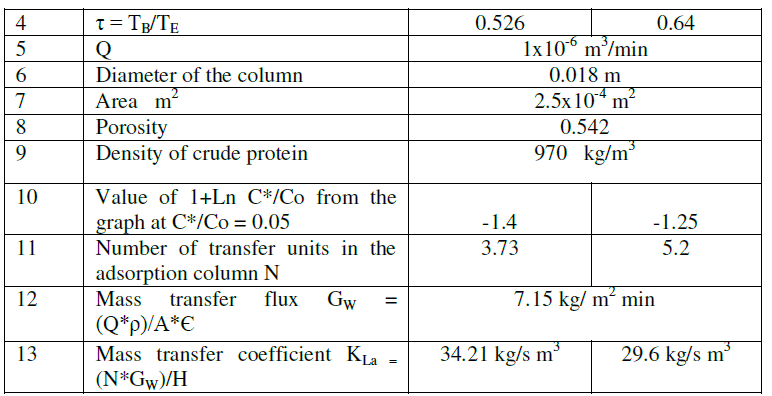 |
| The results obtained (Table 2.0) indicates that the mass transfer coefficient increases with increase in bed height and more for the porous material than the non porous material, from the above results we can conclude that though the percentage of adsorption was more in case of zirconium but the mass transfer coefficient is less because of less porosity compare to the alumina ceramic particle. |
| Characterization of SEM: The SEM was conducted to determine the particle size and morphology of the NSZ |
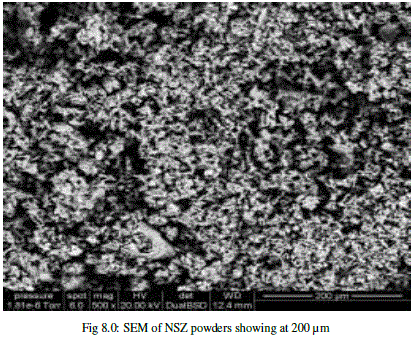 |
| Particles at magnification of 500X. The SEM results (Fig 1.0) show that the particles are agglomerated with an average particle size of 3 μm, with tap density in the range of 0.084 g/cc flake like morphology showing large vacuum space. |
| Characterization of separated protein: COD: The characterization of separated protein was done by determining the chemical oxygen demand of sewage water by adding the coagulant proteins separated from moringa oleifera using NSZ ceramics and the results obtained were compared with the coagulant proteins purified by IEX chromatography method to verify the purity of the separated group of coagulant proteins using nano ceramics with IEX chromatography method. |
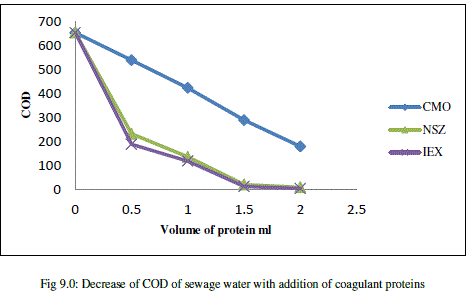 |
| The graph (Fig 5.15) represents the decrease in COD of sewage water for addition of coagulant proteins separated using NSZ particles and IEX method. There was a decrease in COD to 98% by adding NSZ and to 99% by adding coagulant protein separated by IEX this indicates the coagulant proteins separated by using NSZ particles holds more pure and equal to the proteins purified by IEX method. This indicates the NSZ particles can be used to purify the proteins in for with the IEX method. |
CONCLUSION |
| In adsorption process where NSZ particles was used as a adsorbent material purifies the protein to standards nearly equal to that obtained from IEX chromatography. Also the isotherms show that it is feasible to scale up the process. The constant wave approach was used to develop explicit equation for the breakthrough curves of fixed bed adsorption processes with the Freundlich adsorption isotherms. The column test runs for adsorption of protein were performed and from the results it was inferred that experimental and predicted breakthrough curves were in good agreement. The mass transfer coefficient determined was independent of bed depth but increased with increase in number of transfer units. |
| Acknowledgment: The authors gratefully acknowledge Rastreeya Shikshana Samithi Trust for extending support and facilities. |
References |
|